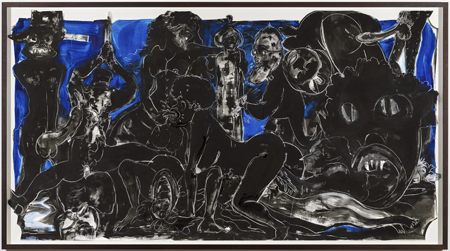Kara Walker
Victoria Miro, London, UK
Victoria Miro, London, UK

On 17 June 2015, a white man opened fire on a prayer group in Charleston, South Carolina, killing nine people. Nine black people or, rather, ‘nine more’, as the US artist Kara Walker puts it in an interview with photographer and filmmaker Ari Marcopoulos, published alongside ‘Go to Hell or Atlanta, Whichever Comes First’ – the first of two solo shows across Victoria Miro’s London spaces. After the shooting, pictures emerged of the gunman posing in front of the Confederate flag – a relic from the Civil War, now shorthand for white supremacy – sparking protest over its continued display in a number of US states. Racism was supposed to be a thing of the past, so why was a symbol so closely associated with it still flying?
It’s a contradiction that is familiar to Walker: at the age of 13, she moved to Atlanta, Georgia, a city that boasts Stone Mountain as one of its dubious attractions. This massive Civil War monument is situated at the so-called spiritual birthplace of the Ku Klux Klan; Martin Luther King Jr. referred to it in his ‘I Have a Dream’ speech in 1963 (‘Let freedom ring from the Stone Mountain of Georgia!’). The mountain remains a tourist spot to this day, continuing to promote what Walker describes as ‘a living ahistorical fantasy war’: a fabricated version of past events.
Walker returned to Stone Mountain following the Charleston shooting, and this trip was the inspiration behind ‘Go to Hell or Atlanta …’, which opened at Victoria Miro’s Wharf Road gallery in October. In the exhibition, Walker exploded the mythology and visual symbolism surrounding the controversial monument. On the first floor were Four Idioms on Negro Art (all works 2015): four large-scale paintings rendered in a folksy style. The Idioms depict minstrel-like figures tangled in orgies of violence, rape and police brutality. Walker here recycles and subverts racist and sexist tropes, digging them up from the recesses of culture.

These paintings were accompanied by 12 preliminary sketches, Tell Me Your Thoughts on Police Brutality ‘Miss Spank Me Harder’, revealing more about Walker’s process and providing thematic signposts. One lists the distinguishing features of high art (‘upper class’, ‘masculine’) vs. low art (‘low class’, ‘feminine’); underneath each category the artist has scribbled: ‘That’s Me!’ Others appear to reference the killings and assaults that have fuelled the Black Lives Matter campaign. There’s a drawing of a black man in what looks like a body bag, under which the all-too-familiar phrase ‘unarmed black man’ is written. Another shows a naked black woman being straddled by a clothed white man, recalling the viral video footage of police officer Eric Casebolt wrestling a girl to the ground at a house party in Texas in 2015. The Idioms may look archaic, but these sketches ground them firmly in the present.
The show reached its apex on the second floor, where Walker’s expansive cut-paper work, The Jubilant Martyrs of Obsolescence and Ruin, rampaged across an entire wall. Paper cutting is the medium Walker is best known for – delicate, skilfully made silhouettes resembling those made by 19th-century hobbyists, but with wildly different subjects. Like all of her cut pieces, The Jubilant Martyrs ... was made on site and it crackles with movement and energy. The ‘fantasy war’ of Stone Mountain is animated: a Confederate soldier stands on a pile of bodies, horses rear and a whip-wielding escaped slave woman is poised to wreak her revenge. A black and white photograph of the monument, made in collaboration with Marcopoulos, covered the back of the room. Seeing it – realizing Stone Mountain exists physically, as well as imaginatively – delivered a shock.
The technical skill manifest in The Jubilant Martyrs … is also on display at Victoria Miro Mayfair, in ‘Norma’. This exhibition presents Walker’s preparatory sketches, drawings and models from the production of Vincenzo Bellini’s 1831 opera, which she directed and art directed at Teatro La Fenice in May and June 2015. Commissioned by Okwui Enwezor, to coincide with the 56th Venice Biennale, Walker’s update on Bellini’s tale of a Druid princess who falls in love with, and is then rejected by, a Roman proconsul, transplants the story of sex, power, subjugation and rebellion from Roman Gaul to an unspecified 19th-century African colony.
Vibrant watercolours and pastel drawings illustrate Walker’s plans for costumes. The show also includes an elegant cardboard model of the stage design, which takes the form of an African mask whose contours resemble mountain ranges. Walker’s vision for the opera centred upon a colonial-era photograph of an enigmatic Congolese woman that she found while researching: ‘She is my Norma, unconquered and unclothed,’ the artist writes in the show’s catalogue. Norma is depicted in a beautiful drawing, Untitled, which emphasizes her decorative skin scarring and defiant stare.
Both ‘Norma’ and ‘Go to Hell or Atlanta …’ demonstrate Walker’s knack of conflating different eras: Roman Gaul and colonized Africa in the former; Klan-era and present-day America in the latter. She confronts us with the past, revealing how it is more present than we’d like to admit. In these two shows, Walker levels the ‘then’ and the ‘now’ to gut-punchingly powerful effect.
























